KENWOOD TS-940S
MODS
I had struggled to achieve a
balanced TX audio frequency response (that I liked) due to
the limitations of the TS940 and my higher pitched and
somewhat nasally natural voice. As of now, after the mod's
below I am very satisfied with my station sound!
The stock 940 will pass some
very low frequency response with a compromise in the mid to
high end. You can adjust the carrier points to remove
some lows and increase the mid to high response but I have
not been happy with just the carrier point adjustments.
The stock filter set (8830K & 455K) provides about 2.4K
total bandwidth and this is not really sufficient to pass or
receive the high quality audio I desired. The mod's below
along with my processing equipment have helped me achieve a
more balanced smooth sound.
BALANCED MODULATOR MODIFICATION
I made this modification to
the audio circuit in the TS 940 (thanks to Terry, W6RU) and
it has improved the TX audio response dramatically!
Before the modification I ran the output from my DBX gear
into the phone patch input on the back of the 940. In
the past I also had run the audio gear directly into the mic
jack in front of rig. Both of these configurations
achieved the exact same result (not a lot of clean low end
and lacking mid to high response). It was much better
than just running the mic without the processing gear but it
still was not what I wanted so ... With Terry's help I
located the balanced modulator diode on the IF PC board and
applied the audio from my outboard processing equipment
directly ... well almost directly.
I installed a small SPDT
switch that I use to select the audio (stock mic vs outboard
audio) to apply to the balanced modulator. The outboard audio
source is appled to the - side of C206 on the IF board. I use
a 22Mfd capacitor in the audio + to provide proper coupling.
Click here to see a schematic of the hook up. This configuration completely bypasses two small
audio amplifiers that are stock in the 940. It also
bypasses the mic gain control. It appears to me that
one or all of the bypassed components were restricting the TX
audio response. Now... this modification is not for
everyone ! If you use VOX it won't work without
additional tinkering. The VOX circuit requires audio to
be applied well before C206. For my application I was
able to apply audio from the unused right output of my
MicroVerb4 to the mic jack on front of rig. This audio
allows the VOX circuit to work. Click here
to see my audio connection map
The balanced modulator
modification detailed above did improve my sound (in my
opinion anyway ;-) but it still lacked sibilance ! The
next modification I performed was to replace the stock 940
filters (both 8830 & 455) with stock TS930 filters.
The TS940 uses somewhat narrow 2.4 kHz filters and this was
affecting my TX & RX audio response. The stock 930
filter set is a bit wider (2.7 or 3.0 as I understand it).
The audio is applied to the 455 filter just after the
balanced modulator. From the 455K filter the audio is
applied to the 8830 filter. Replacing the filters
provides a bit wider TX & RX audio response. Please
see the details of this change below!
FILTER MODIFICATION (2.8KHz
bandpass)
As stated above, the stock TS-940
bandwidth for transmit & receive is 2.4kHz and this does
not provide the frequency response (TX or RX) that I desired.
So... I found (thanks to Zimbabwe, N4MXZ) that the stock
filters used in the TS-930 were wider (each filter provides
around 3kHz bandpass) than the stock TS-940 filter set. After
some study of the frequency configuration for my rig I
determined that both filters were affecting the TX & RX
frequency response. I decided to replace both of the
stock filters with the wider TS-930 filter set.
I completed the installation
on 9/09/99 ! Luckily, one of the audio nuts from 14.178
(Jim, W6FZC) was on the air and he was the first station I
had the opportunity to hear. I immediately noticed a
huge improvement in the RX audio. I had never heard Jim
sounding so good ! I made a quick contact and confirmed that
things sounded different. My audio was a bit to heavy
on the low end during the initial testing of the new filter
set configuration. After I confirmed everything on the rig
was still working properly I returned to 20M to do more
testing with Terry (W6RU) & Jim (W6FZC). We
tinkered with the carrier point but I decided that shifting
it up decreased my very high quality low end RX (and TX)
audio response. I ended up keeping the carrier balance
pretty much the same as stock and reducing the low frequency
EQ settings to remove the heavy bass TX response. Jim (W6FZC)
analyzed my station after all the adjusting and reported a
fairly flat response with total bandwidth of 2.874.
INRAD #475 & ICOM FL-257
FILTER SET INSTALLATION (3.6KHz bandpass)
11/29/2002: The stock 930
filterset installation described above does provide very nice
audio response but it is still a tadd narrow. To get a bit
wider bandwidth (around 3.6 + if you push it) the INRAD # 475
(8830kHZ 4000Hz) and the ICOM FL-257 (455kHz 3.300Hz) filters
are the ticket. These filters are not drop in, you will need
to modify the IF board as shown below but it is an easy
"adjustment". Please note that you will need to
adjust the carrier set points for both LSB and USB, this is
easy if you have a signal generator. Click this link to see the procedure I used to
adjust the carrier set points
My TX and RX frequency
response results = around 11Hz to 3600kHz (50W out at 1.800
Hz, 12.5W out at 11Hz and 3600Hz). I can push it to around
3800kHz with the EQ. See more detail regarding this by
following the link above (or click here: carrier point adjustments)
I worked with John (NU9N) on
160M and confirmed the response detailed above. Additionally,
John listened for carrier and opposite sideband surpression
problems. John's comment is that the 940 is performing at a
level he considers to be the best possible considering it's
analog. Very minimal opposite sideband bleed over and no
carrier.
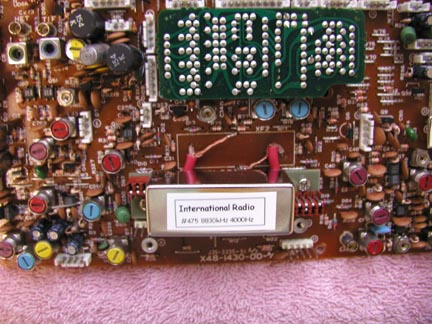 A
A
I mounted the Inrad 475 in
the space on the IF board that the optional AM filter would
go. In order to achieve this, I removed the 4pin connectors
from the IF PC board. The filter then "screwed in".
I used short shielded cable for the the "jumpers"
to the IF board.
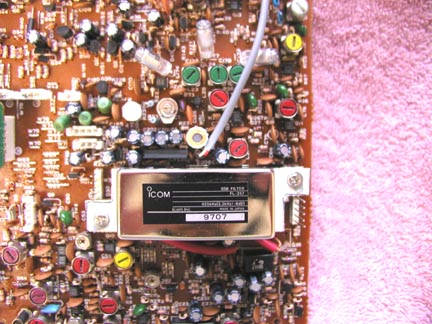
The ICOM FL-257 was mounted in
the space on the IF board that the optional CW (455KHz) would
go. To achieve this, I made a mounting plate out of cardboard.
The connections are made via shielded jumper wires to the IF
board. The grey wire above the filter is attached to C206.
This is the point on the IF board where I apply the audio to
the balanced modulator
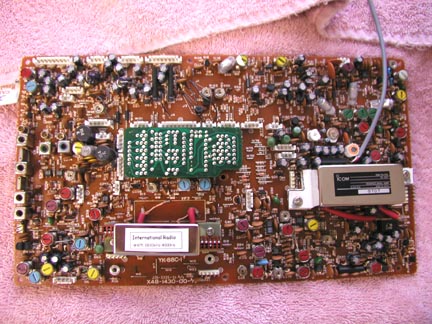
Above is a photo of the
finished IF board ready to install
INRAD #475 and Murata CFWLA455KEFA-B0
(4KHz bandpass)
Simply replace the ICOM FL-257 (3.3KHz)
filter with the Murata, lightly modify the Control Board and set
the carrier set points and TX/RX opens up to just over 4KHz.
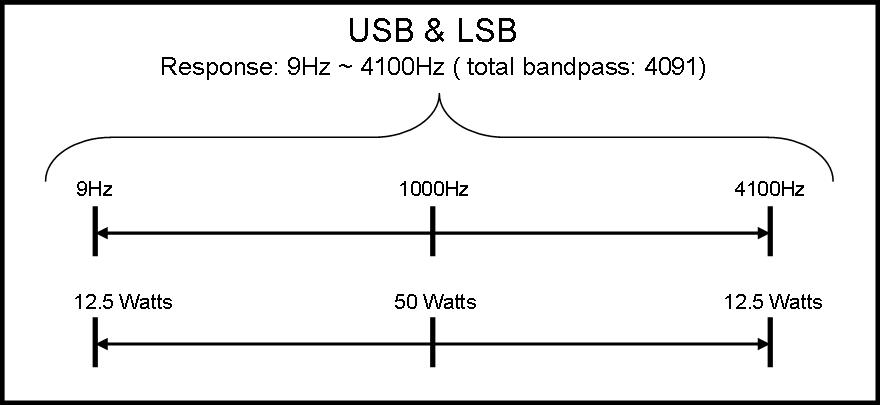
Carrier Board Mods:
Special thanks to: WW4Q
Dominador and "Old Ham Dave" for this mod!
Remove C5 (10pF)
Install 47pF in paralle with TC1
Murata filter installed in the
IF board:
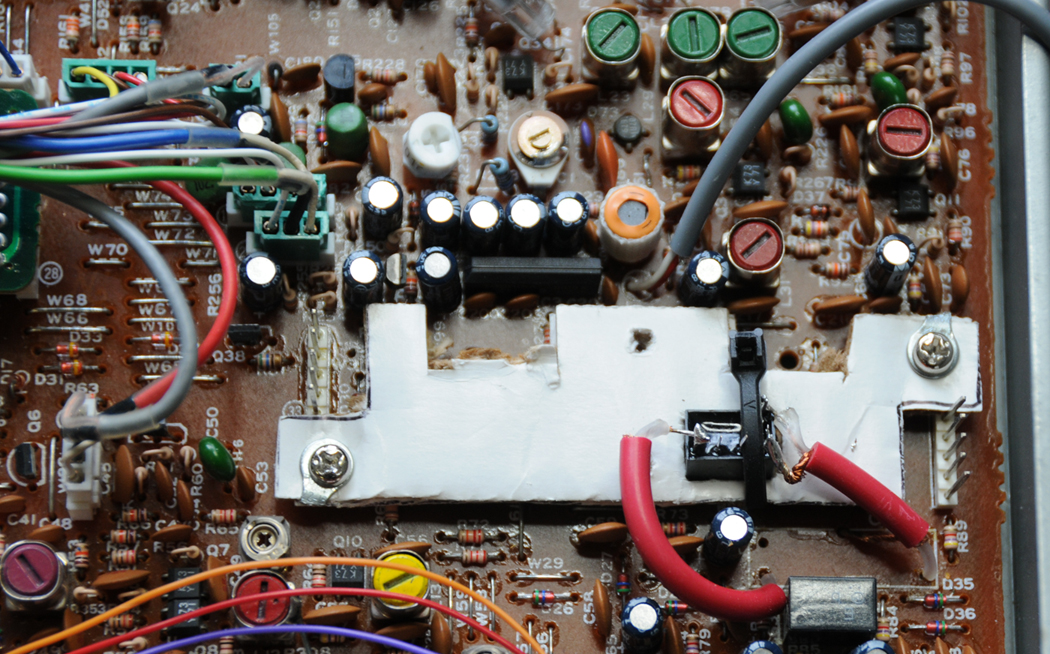
RECEIVER MODIFICATIONS
The TS-940 receiver in stock
form is not acceptable for ESSB or AM operation. The
modifications below will dramatically improve the response and
flatness of the receiver.
Many thanks to John, KI4NR and
Mike WZ5Q for the help and guidance with these mods.
IF Board Mods:
Change C101 from .047uf to .001uf
Change C102 from .022uf to .01uf
Change C103 from 1uf to 4.7uf
Change C143 from .068uf to 4.7uf
non polarized electrolytic
Change C146 from .027uf to .001uf
Change C147 from .047uf to 4.7uf
non polarized electrolytic
Change C148 from .01uf to .1uf
Control Board Mods:
Change C157 from 200uf to 1000uf
Change C170 from .022uf to .001uf
Change C167 from .01uf to 4.7uf
nonpolarized electrolytic
Change C112 from 47uf to 100uf
Change C105 from 10uf to 47uf
Remove C106 (.001uf)
AM Detector
Change C123 from .1uf to 1uf
The spectral plot below was made
after modifications:

RETURN TO HOME PAGE
[email protected]
 A
A



